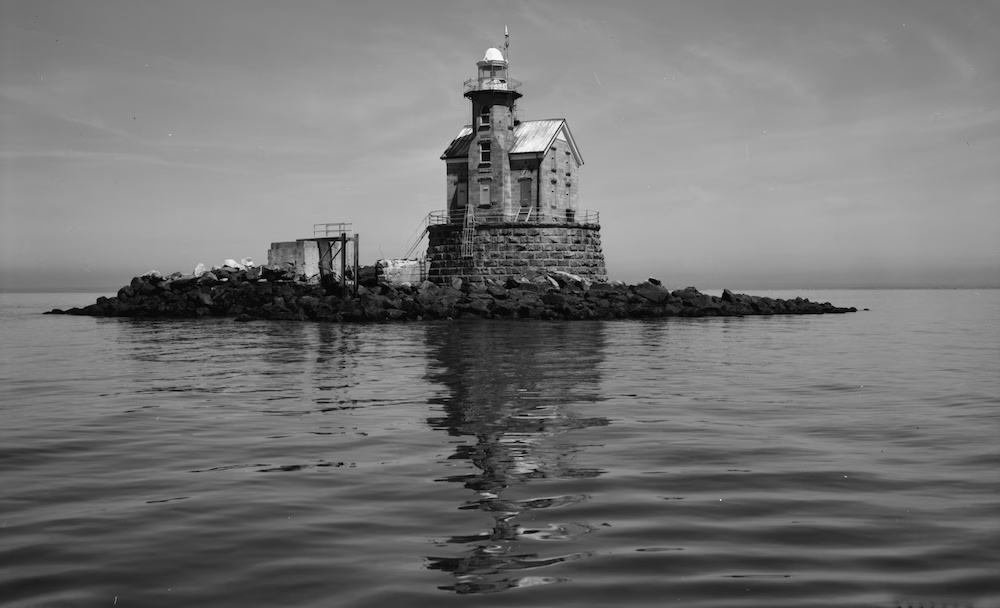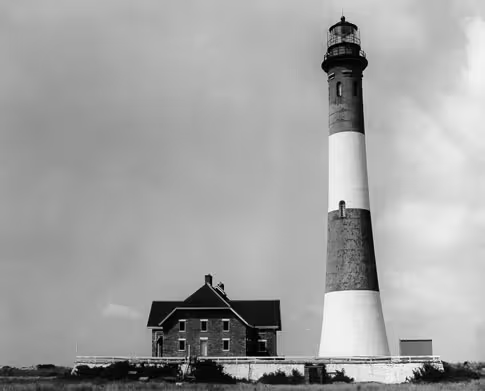Also known as Stratford Shoal Light, Middle Grounds Lighthouse, or “That Thing You See From the Ferry”
Halfway between Port Jefferson and Bridgeport sits a granite fortress that flashes every five seconds and has kept boaters guessing for nearly 150 years. It’s been a light station, a no-man’s-land, and the centerpiece of a federal-state tug-of-war. Here’s everything you didn’t know you needed to know about the Middle Grounds Lighthouse:
Middle of Nowhere Real Estate
-
Stratford Shoal Light sits smack in the middle of Long Island Sound — about 5 nautical miles from Old Field Point and 5.5 from Stamford, Connecticut.
-
Despite being a Long Island icon, the seabed it rests on is legally part of Connecticut.
-
It’s often listed as being in Setauket, New York, but that’s more about mailing addresses than maritime accuracy.
-
It’s only accessible by boat — there are no docks, piers, or helicopter pads.
-
The lighthouse is perched on a natural shoal roughly 1.4 miles wide, smack between Stratford Point, CT and Old Field Point, NY — hence the nickname “Middle Ground.”
Built to Replace a Floating Failure
-
The shoal was first marked for navigation in 1820 with a pair of buoys.
-
In 1838, a floating lightship was anchored to the site. It was the first of at least three lightships used there.
-
These vessels acted as mobile lighthouses but were prone to drifting in storms or ice.
-
In winter, ice floes would batter the ships and make the area extremely dangerous.
-
Congress finally had enough and funded a permanent lighthouse in 1876; it was completed in 1877.
-
The structure sits atop a manmade granite island built over the shoal.
-
The granite used in the lighthouse came from Vinalhaven, Maine, known for its durability in maritime construction.
-
At roughly 2,000 square feet, the building is compact but solid — thanks to 2.5-foot-thick granite walls.
A Bit of Geologic Ghosting
-
In 1614, explorer Adriaen Block mapped two low-lying islands in this area.
-
By the early 1700s, both had eroded below sea level, leaving behind the treacherous Stratford Shoal.
-
What’s there now is mostly underwater — except for the lighthouse sitting stubbornly above it all.
Life at the Light
-
Before automation, lighthouse keepers were stationed here year-round, often enduring severe isolation.
-
The station was considered a highly undesirable post due to its remoteness and brutal winters.
-
The lighthouse had a Fresnel lens and a first-class fog bell when it was active.
-
The structure sustained repeated damage from ice pressure, a constant threat in the colder months.
-
The lighthouse was automated in 1970, and its original lens was removed.
-
It now flashes every five seconds and sounds a foghorn every fifteen — powered by solar panels and batteries.
-
Though no longer vital for navigation thanks to GPS, the U.S. Coast Guard still maintains it as an active aid.
Why You Can’t Stay There (But Someone Tried)
-
Under the National Historic Lighthouse Preservation Act, the U.S. government offers old lighthouses to nonprofits or government agencies first.
-
If no suitable steward is found, it goes to public auction.
-
In 2023, Stratford Shoal went up for auction with a starting bid of just $10,000.
-
It was one of ten lighthouses offered that year, part of a program that has raised over $10 million for the Coast Guard since 2000.
Meet Nick Korstad: The Guy Who Tried to Make It Work
-
Lighthouse collector and preservationist Nick Korstad was awarded stewardship of Stratford Shoal in 2014.
-
He’s owned or cared for several lighthouses, including Borden Flats Light (MA) and Spectacle Reef Light (MI).
-
His plan was to restore Stratford Shoal and offer week-long overnight stays to the public.
-
He filed hundreds of pages of paperwork through the U.S. General Services Administration to take stewardship.
-
But there was a catch: the seabed under the lighthouse is owned by Connecticut, which required a lease.
-
When Connecticut learned about his plan for overnight stays, they viewed it as a commercial hotel use — not allowed under preservation rules.
-
That clashed with the federal stewardship agreement and created a regulatory standstill.
-
Nick stepped away from the project in 2022 after eight years of back-and-forth.
-
“Eight years into the process I figured it’s best not to pursue it,” he said.
-
Fun fact: despite holding stewardship, Nick hasn’t visited the lighthouse since 2015.
A Trophy Home With No Bathroom
-
Nick estimates the structure is worth around $350,000, but would require at least $500,000 in restoration to be usable.
-
Needs include:
-
Painting the lantern room
-
Installing new windows
-
Restoring hardwood floors
-
And yes — installing a bathroom (there currently isn’t one)
-
-
Lighthouse keepers once used bucket or chemical toilets — there has never been modern plumbing.
-
There are no utilities or septic systems, and transporting workers and supplies requires a boat.
-
Structurally, the building is in great shape, thanks to its Vinalhaven granite construction.
-
Nick now prefers lighthouses on land and says a buyer would need “deep pockets and a boat.”
Lighthouse Auction
-
The lighthouse went up for public auction online in 2023.
-
The Stratford Shoal Lighthouse online auction closed on September 13th, 2023.
-
It was awarded to the highest bidder, Mr. David S. Boyd.
-
The closing occurred on October 11, 2024.
-
Once purchased, the structure can be used however the owner sees fit — but state regulations and taxes still apply.
-
Leasing the underwater land from Connecticut would be necessary.
-
But technically, you could make it a private retreat, an artist studio, or the most inconvenient man cave in America.




